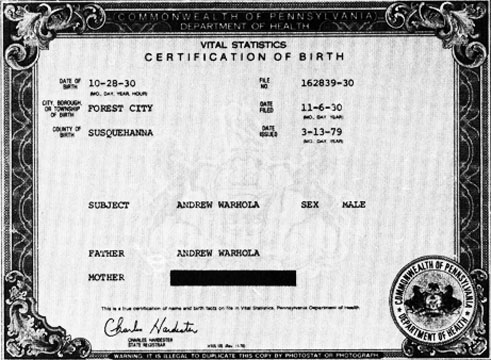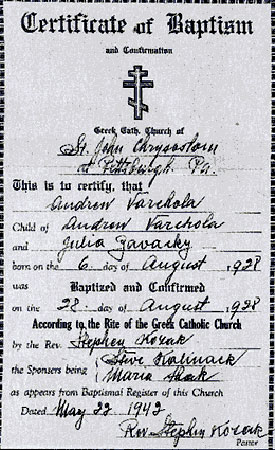Andy Warhol: From Nowhere to Up There
an oral history of Andy Warhol's early years
by Gary Comenas
page two
Carter Ratcliff (1983): According to a birth certificate reproduced by Jean Stein and George Plimpton in Edie: An American Biography, the artist was born on September 28, 1930, in Forest City, Pennsylvania, a small town northeast of Scranton. (CRA11)
Jean Stein (co-author of Edie: An American Biography, 1982): This is the document the State of Pennsylvania provided when asked for the birth certificate of Andrew Warhola, born in 1930: (JSE190)

Bob Colacello (Interview magazine editor): Andy had something… to worry about in 1982. The big beach book that summer was Edie: An American Biography by Jean Stein, edited by George Plimpton. It presented Andy as a craven manipulator and an amoral voyeur, who had the other Superstars keeping tabs on Edie Sedgwick’s drug taking so that he could be there with his movie camera when she overdosed... He was particularly infuriated by a birth certificate reproduced in the book, for an Andrew Warhola, born in Forest City, Pennsylvania on October 28, 1930... 'This is not my birth certificate,' Andy wailed. 'This is not my birth certificate. Oh, I hate Jean Stein. I really, really hate her.' Really, really meant really, really. (It wasn't Andy's birth certificate: Forest City High School records show that that Andrew Warhola graduated in 1947 and applied to a pre-dental program at the University of Scranton. His photograph on file bears no resemblance to Andy.) (BC459-60)
Andy Warhol (6 August 1984): Oh, it's all Fred [Hughes]'s fault that I'm in that book. He kept after me to talk to Jean Stein. Because she was 'social,' my dear, and was having parties. So me talking to her made it look like I sanctioned her book. (AWD593)
Bob Colacello: …according to his two brothers, on August 6, 1928, a doctor delivered Andy at home in Pittsburgh. The only birth certificate that exists was filed in Pittsburgh in 1945, when it was required for Andy’s college application. This document notes affidavits sworn by Julia and an old family friend, Katrena Elachko. Her son, John Elachko, says, ‘My mother would never lie about a thing like that’ and also points out that many immigrants of that generation, including himself, didn’t have birth certificates. (BC14)

Although Andy Warhol may not have had a birth certificate issued at the time of birth, his Certificate of Baptism shows his date of birth to be 6 August 1928
Paul Warhola (Deceased eldest brother of Andy Warhol): This is Paul Warhola. I'm the brother of Andy and John. I'm located here 40 miles south of Pittsburgh on a farm with about 38.5 acres. I was the oldest of a family of three, but I guess you know that. I remember very well when Andy was born. He was born on August 6, 1928. I also remember when John was born. I was smaller then. We went for the doctor and Dad was still leading me by the hand. When Andy came into the world I heard mum screaming and then somebody said - it's half past five.
Andy was born right in Pittsburgh, in a community called Soho. We lived at number 73 Orr Street, just next door to the Lithuanian National Building. I was born there and we stayed there a whole ten years. We moved to Oakland - that's another neighbourhood in Pittsburgh - sometime around 1934. Andy was somewhere around 6 years old and I was twelve at that time. (RU52)
Victor Bockris (Warhol biographer): By the time Andy was born in his parent’s second-story bedroom on 6 August 1928, his father Ondrej (Andrew) and mother Julia Warhola had been living for nearly ten years in the narrow red-brick two-room shanty at 73 Orr Street… Their first son, Paul, had been born on 26 June 1922, their second son, John, on 31 May 1925. The Warholas were Rusyns who had emigrated to America from the Ruthenian village of Mikova in the Carpathian Mountains, near the borders of Russia and Poland in territory that was, at the turn of the century, part of the Austro-Hungarian Empire… (VB15-16/20)
Bob Colacello: 'I come from nowhere,' Andy once said. And, for once, he wasn't lying. Ruthenia, the Eastern European land of his parents and grandparents was nowhere. It can't be found on any maps - it's in the Carpathian Mountains, just north of Transylvania, at the point where the present-day boundaries of Poland, Czechoslovakia, Hungary, Rumania, and the Soviet Union meet. Its rulers - the Austro-Hungarian Empire until World War I, Czechoslovakia and Russia since then - have systematically denied the identity of its people as a distinct nationality. (BC11)
Vladislav Grešlik (Co-curator of "Andy Warhol as Andrijko Varchola from Mikova"): Although Ruthenians (Rusini - an ethnonym dating from the times of the Kievan Rus), had lived for centuries as quite a compact population first in the lowlands, and then (after being displaced) mainly in the foothills and mountainous parts of the Carpathian range, in terms of government and local administration they had never belonged to any official regional administrative territory corresponding to their ethnic settlement. The first serious attempt to create such an administrative unit at least partially came only with the founding of Czechoslovakia, which as a result of the new European order established after the First World War was given the territory officially known as Sub-Carpathian area of the Ukraine both before, and after Ukrainian independence in 1991, but a large part of the territory inhabited by Ruthenians remained within Slovakia. Other slices of territory inhabited by Ruthenians went to Poland, Romania and Hungary.
... From the end of the 19th century a massive wave of Ruthenian emigrants headed for North America, above all to the USA (especially the state of Pennsylvania) and Canada, where initially they found heavy manual work in the mines, smelting and forestry. Today their descendants are usually to be found in areas of the US with the same economic focus (e.g. Pittsburgh with its Rusyn Valley, Passaic and elsewhere) where many still preserve a Carpathatian Ruthenian or 'Carpathian Rus' ethic consciousness, aided by various cultural and social organisations (e.g. the Carpatho-Rusyn Society, Carpatho-Rusyn Research Center and others). (RU20)
Ian Willoughby (Prague journalist): The birthplace of Warhol's parents, the village of Miková, was still part of the Austro-Hungarian Empire when his father Andrij Warhola, like many Ruthenians, emigrated to the US in 1914, shortly before the outbreak of the First World War. The state of Czechoslovakia — created after the dissolution of the Austro-Hungarian empire — has [sic] been in existence for only three years when Julia followed Andrij to America in 1921. So while Julia was technically “from” Czechoslovakia, Andrij arguably was not. (IW)
Rudo Prekop (Editor of Andy Warhol and Czechoslovakia): Andy's father Andrej Varchola (born 1886) ... first went to the United States to find work at the beginning of the century (sometime after 1900). He returned in 1909 and in the same year on May 22 Andrej Varchola married Jülia, née Zavacká - 'zavaczki' in Miková.
After the wedding (in 1910 or 1912) Andrej went back to America, this time accompanied by his younger brother Jozef (born 1890). (RP34)
Elaine Rusinko (Author of "We Are All Warhol's Children:" Andy and the Rusyns): Andrii left Miková in 1912 to escape being drafted into the army of the Austro-Hungarian Empire, of which he was then a citizen. (ER11)
Rudo Prekop: His (Andrej's) youngest brother Jan (born 1893) stayed with his mother at home. After the outbreak of the First World War, Jan, unlike his brothers, had to join up in the Austro-Hungarian army. He was wounded on the battlefield and after the war died of his injuries. (RP34)
Elaine Rusinko: Detained by World War I, Julia joined her husband in Pittsburgh nine years later, by which time Miková was part of the newly formed state of Czechoslovakia. (ER11)